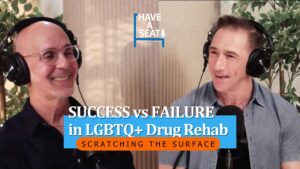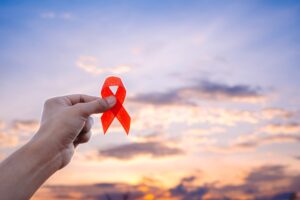More than 1.2 million people in the United States are living with human immunodeficiency virus (HIV). HIV is the virus that causes acquired immunodeficiency syndrome (AIDS). Of that number, some 50% report current or past drug and/or alcohol use disorders. A percentage that high begs the question—is HIV and substance abuse a recipe for disaster?
What is HIV?
First identified in 1981, HIV (human immunodeficiency virus) attacks the cells that help the body fight infection. As a result, people living with HIV are more vulnerable to infections and other diseases.
HIV is spread through contact with blood or other bodily fluids of a person with HIV. Most often, transmission occurs through condomless sex or through sharing needles. It can also be spread from mother to child during pregnancy or breastfeeding or through infected blood transfusions.
The human body isn’t able to get rid of HIV and no cure exists. In other words, once you have HIV, you have it for life. Left untreated, HIV can lead to AIDS (acquired immunodeficiency syndrome). AIDS occurs when the body’s immune system is badly damaged by the virus.
Thanks to HIV medicine (called antiretroviral therapy or ART), few people in the United States develop AIDS. Rather, people with HIV can live long, healthy lives. In addition, those without HIV can take medications like pre-exposure prophylaxis (PrEP) and post-exposure prophylaxis (PEP) to prevent getting HIV through sex or drug use.
What’s The Connection Between HIV and Substance Abuse?
HIV and substance abuse have been closely linked ever since HIV was identified in the early eighties. In fact, nearly 50% of persons living with HIV/AIDS report current or past histories of drug and/or alcohol disorders.
Today, illicit drug use is an important driver behind the spread of HIV around the world. Intravenous (IV) drug use is a particularly concerning risk factor for transmission of the virus. Approximately one in 10 HIV infections occur among people who inject drugs.
But the danger between substance abuse and HIV/AIDS doesn’t end there. Not only does substance abuse play a role in the transmission of the disease, but it also plays a powerful role in the diagnosis, progression, and treatment of HIV/AIDS. The next section provides more detail about how.
Health Risks For Substance Abuse And HIV
As mentioned in the previous section, substance abuse poses risks for acquiring HIV, transmitting the virus to others, and the progression of the disease.
Let’s take a closer look at the connection between substance abuse and HIV.
Increased risk of acquiring and/or passing HIV
Substance use and abuse can put you at a greater risk for acquiring and/or transmitting HIV. One of the main reasons is because drugs affect your brain, altering your judgment and lowering your inhibitions.
When you’re drunk or high, you may be more likely to make decisions that put you at risk for getting and/or passing HIV. For example, you may share needles or syringes, have sex without using a condom, use condoms incorrectly, or have more sexual partners than you would otherwise.
All of these behaviors can increase your risk of exposure to HIV and other sexually transmitted diseases. If you already have HIV, such behaviors may cause you to pass HIV to others.
Poorer health outcomes for those already diagnosed with HIV
Substance abuse among those already living with HIV is problematic for several reasons.
First off, substance use can hasten the progression of HIV by suppressing the immune system. When this happens, it’s more difficult for the body to manage the virus.
In addition to weakening the immune system, drugs make it easier for HIV to enter the brain. Upon arrival in the brain, the virus triggers the release of neurotoxins. These toxins can cause chronic neuroinflammation. Neuroinflammation can lead to problems with memory and concentration. It also creates an increased risk of developing degenerative brain diseases similar to Alzheimer’s disease.
Substance use can also worsen the progression of HIV because of its impact on medication adherence. Following a medication schedule consistently is essential for keeping the virus at bay and preventing the disease from worsening.
Those who use and abuse substances often have difficulty adhering to these complex and inconvenient schedules. Failure to stick to a medication regimen not only impacts the health of the individual in question but can also increase the risk of acquiring and spreading a more virulent, drug-resistant form of the disease to others.

Treatment For HIV And Substance Abuse
The main goal of substance abuse treatment is to reduce or stop drug use. Once that objective is achieved, the next goal is a sustained reduction of high-risk behaviors. Such behaviors include sharing needles or engaging in unprotected sex. Over the long term, the goal is to help people maintain positive behaviors and to control relapse triggers.
While there’s no simple way to achieve these goals, research indicates that combining mental health treatment with substance abuse treatment is key to ending substance use. This makes sense considering that among HIV-positive individuals, 10-28% report co-occurring psychiatric and substance abuse disorders like depression, anxiety, and mood disorders.
This dual-pronged treatment style helps reduce and/or eliminate substance use. In addition, it’s been shown to improve adherence to antiretroviral therapy (ART) and reduce the prevalence of risky behaviors.
Treatment challenges
Not surprisingly, substance abuse treatment for those living with HIV is not without its challenges. Individuals who fall into this category are likely to drop out of treatment due to fear, stigma, and denial.
Failure to get the necessary help can lead to continued and worsening substance abuse, escalation of psychiatric symptoms, reduced ART adherence, and poorer physical health.
Treatment is also challenging because HIV disproportionately impacts people with limited economic resources. As a result, many are uninsured and unable to afford inpatient substance abuse treatment.
How to improve treatment outcomes
Better treatment outcomes, start with better HIV-related primary care. Providers should screen all HIV+ patients for ongoing or recurrent drug and alcohol use and abuse. It’s essential that providers come with a nonjudgmental attitude. When patients feel comfortable, they’re more likely to share sensitive information.
As mentioned previously, it’s also important to treat HIV, substance abuse, and mental health conditions (if present) in an integrated manner. In other words, physicians and other healthcare professionals should communicate with one another on a regular basis. This ensures that patients receive better care and have more successful treatment outcomes.
In terms of improving access to treatment, outpatient services, combined with twelve-step programs, can be helpful in the recovery process. That’s especially true of meetings where discussion of HIV is welcome or accepted.
La Fuente Provides Culturally-Sensitive Treatment
La Fuente is an LGBTQ-affirmative treatment center located in Los Angeles, California. Our mission is to provide top-notch care that takes into account the ethnicity, socioeconomic status, gender identity, HIV status, and sexual orientation of each and every one of our clients.
If you’d like to know more about our programs, complete the form below and a member of our staff will contact you within 24 hours.





